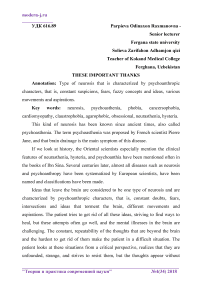These important thanks
Автор: Parpieva O.R., Solieva Z.A.
Журнал: Теория и практика современной науки @modern-j
Рубрика: Основной раздел
Статья в выпуске: 4 (34), 2018 года.
Бесплатный доступ
Type of neurosis that is characterized by psychoanthropic characters, that is, constant suspicions, fears, fuzzy concepts and ideas, various movements and aspirations.
Neurosis, psychoasthenia, phobia, cancersophobia, cardiomyopathy, claustrophobia, agarophobic, obsessional, neurasthenia, hysteria
Короткий адрес: https://sciup.org/140273143
IDR: 140273143
Текст научной статьи These important thanks
This kind of neurosis has been known since ancient times, also called psychoasthenia. The term psychoasthenia was proposed by French scientist Pierre Jane, and that brain drainage is the main symptom of this disease.
If we look at history, the Oriental scientists especially mention the clinical features of neurasthenia, hysteria, and psychoanthia have been mentioned often in the books of Ibn Sina. Several centuries later, almost all diseases such as neurosis and psychoanthropy have been systematized by European scientists, have been named and classifications have been made.
Ideas that leave the brain are considered to be one type of neurosis and are characterized by psychoanthropic characters, that is, constant doubts, fears, intersections and ideas that torment the brain, different movements and aspirations. The patient tries to get rid of all these ideas, striving to find ways to heal, but these attempts often go well, and the mental illnesses in the brain are challenging. The constant, repeatability of the thoughts that are beyond the brain and the hardest to get rid of them make the patient in a difficult situation. The patient looks at these situations from a critical perspective, realizes that they are unfounded, strange, and strives to resist them, but the thoughts appear without dependence on his will and will. The patient can not overcome them independently.
The obvious clinical manifestations of ideas that go beyond the brain are phobia and various ideas in the brain (obsessions).
Phobias is a fear-inspiring fear. The danger of cancerous fever -cardiomyopathy - fear of non-recurring heart disease, lycophotography - fear of mental illness, clustrofobia - fear of a closed place (for example, lift cabin, small room), agarofobia - on the contrary, fear, and so on. Symptoms such as height, submergence, infectious disease, dirtiness, and fear of speech are common to the phobias.
The first fears appear in certain situations, and this fears are in the brain. For example, the patient appears on the roof to look at the face and, when facing down, he is terribly scared, his head turns, as if he is flipping down and falling down. As a result, the fear of elevation in the patient stays in the brain and can then be seen in other situations. The fear first appears when it is necessary to rise above the height and then to rise to the height and then to assume that it is necessary to rise to that level. In the patient, elevated fear situations increase. Now he is afraid to walk in the elevator and look at the window, and he fears even if the height is not so great.
When the phobias appear, vegetative symptoms can also be seen: the patient's face is red or red, his mouth is drooping, his heart beats frequently, increases arterial pressure, sweats, the eyelids are expanded, and so on.
Fear of a serious internal organs usually occurs with psychosomatic symptoms - that is, the patient is paying too much attention to his or her own health. For example, he hears heartbeat in cardiomyopathy, counting pulse or measuring arterial blood pressure, suspicion of heart failure, and requests the therapist to do ECG and conduct a thorough examination.
Being afraid of an incurable illness, the patient moves from place to place, chooses a route close to medical facilities, and goes to a pharmacy on the way, where he sees the presence of heart medications and medical staff.
Obsessions are suspicious thoughts that go beyond this brain, and are rising slowly. They will concentrate on the patient's wishes and will. These thoughts are painful to the patient, they do not really like it, and they can not be saved without a doctor's help. For example, when the patient is out of his house, his mind is disturbed, such as locking the door, shutting the fire, or hiding the water. He goes back to his house, checks the whole place, and when he is sure he is in the place, he goes out quietly. After a short distance from the house, the dazzling points are still coming back and back home. He's crying because he's tired and never goes out. Of course, the patient looks at these symptoms and wants to get rid of them, but never can.
Occasionally, the patient appears to have logical disagreements. For example, when the car approaches, the car is suddenly frightened and retracted. Some patients' thoughts are like stabbing themselves or someone else, and they do not go near the knife or close it.
The neurosis of the brain, which does not go away from the brain, ceases to be effective in timely treatment. In some cases, it may take up to a few months or even years. There are also emotional illusions that can be traced to the remission: the patient will be well-versed for months, and then again will be thoughtprovoking. Contrary to neurasthenia and hysterical neurosis, thoughts that leave the brain tend to be chronic. Most patients, even after being cured, are more than happy to wait for the same symptoms.
Список литературы These important thanks
- Вышняк Г.Н. Геренерализованные заболевание пародонта. -Киев-1999-С.216.
- Ziyonet.uz


